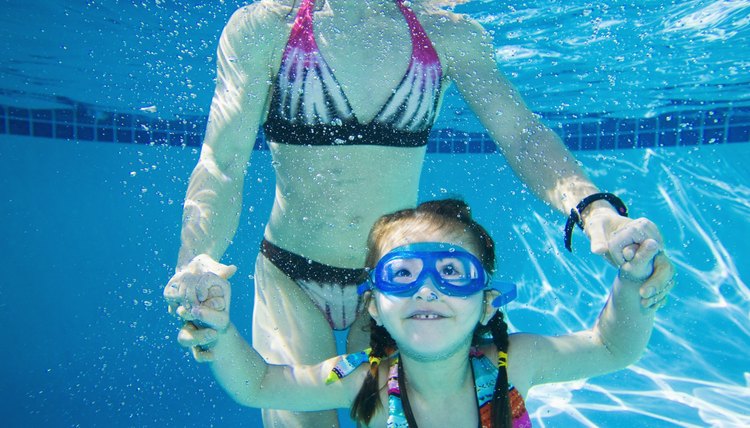Swimming Lesson Ideas for Kids Having Trouble Holding Their Breath

Learning swim strokes can be difficult enough for many kids. Trying to master holding the breath at the same time as learning different strokes might put the challenge over the top. A few swim lesson ideas that focus on breathing technique might help your youngster work out the kinks, so she'll be swimming with ease.
Practice Breath-Holding
Spend some time practicing breath-holding if kids are struggling with this aspect of swimming, advises swim instructor John Tarney, of Swim Lessons Made Easy. Show the kids this technique by first blowing out all the air in your lungs through your mouth and then taking a deep breath in through your mouth. Hold your breath for about 10 seconds, counting down with your fingers. When you reach 10 seconds, blow out the air and take another big breath to hold your breath again. Invite the kids to hold their breath using the same sequence of blowing out completely, taking a deep breath, holding it and repeating, so they learn the pattern.
Blowing Bubbles
It’s important for a swimmer to empty his lungs between breaths so that, when his face is turned out of the water to breathe, he doesn’t have to exhale first, states USA triathlon-certified swim coach Marty Gaal. To help kids develop this rhythm while swimming, teach the skill of blowing bubbles into the water with the face submerged. Bring the face out of the water to take a breath and then repeat, blowing bubbles again under the water.
Bobbing for Breaths
Once children learn how to hold their breath and release it in a repeated pattern, move on to a bobbing activity that will put their new breath-holding skills into practice. To bob, the child should take a deep breath and hold it, moving straight down to submerge himself completely under the water. While under the water, air is blown out, and then the child should come up again after about two to three seconds. Have the child repeat the bobs between 10 and 20 times, until she seems proficient at the process of blowing out under water and taking a deep breath above the water.
Tapping to Breathe
Work on turning the head to breathe while floating prone in the water. Help a child float on the water with his face submerged, blowing bubbles. Every one to two seconds, tap the youngster on the head to indicate that he should turn his head to the side and take a breath. Perform this breathing-and-blowing sequence until the child feels confident and comfortable.
Writer Bio
Kathryn Hatter is a veteran home-school educator, as well as an accomplished gardener, quilter, crocheter, cook, decorator and digital graphics creator. As a regular contributor to Natural News, many of Hatter's Internet publications focus on natural health and parenting. Hatter has also had publication on home improvement websites such as Redbeacon.
